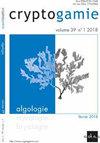Subgen的崛起。Rhoicosphenula Lange-Bert。波多黎各Gomphosphenia s.s.一新种的属水平和描述
IF 1.5
4区 生物学
Q3 MARINE & FRESHWATER BIOLOGY
引用次数: 0
摘要
摘要:红蝶亚属。有一个独特的特征组合,将其与Gomphosphenia亚属区分开来。Gomphosphenia Lange-Bert。特别是,Rhoicosphenula具有与Gomphosphenia相似的条纹/乳晕特征,但与该属的区别在于,在瓣的两极上也有假间隔,在一极上有隔的交配,在束状视图上几乎是矩形的结果。总之,这个特征组合有力地支持它作为一个独立的属遵循现代硅藻分类标准。此外,到目前为止,已知的唯一一种Rhoicosphenula是在一个特殊的酸性和营养不良的栖息地收集的,而大多数Gomphosphenia s.s.物种定居在中等导电性的碱性内陆水域。在LM和SEM研究的基础上,我们还提出了一种Gomphosphenia (G. patrickiana Cantonati, Lange-Bert)。, Kociolek & A.A.Saber, sp. 11)作为科学的新事物。新种的定义主要依据其瓣形外形和尺寸、长宽比、条纹密度和地理分布。在波多黎各的两条溪流的几个样本中发现了它,有时相对丰度很高。朗格伯特的Gomphosphenia patrickiana Cantonati。Kociolek & A.A.Saber, sp. 11 .在营养物(特别是磷)浓度较低、生态完整性较高的河流中含量更高。新物种似乎更喜欢中等碱性的淡水栖息地,具有中-高电导率和低到中营养条件,对氮的富集具有中等的耐受性。同样值得注意的是,新物种出现在镁浓度高于平均水平的溪流中(由于当地地质)。这种新热带、温水物种可能是全球变暖效应的潜在指标。本文章由计算机程序翻译,如有差异,请以英文原文为准。
Rise of Subgen. Rhoicosphenula Lange-Bert. to the Genus Level, and Description of a New Gomphosphenia s.s. Species from Puerto Rico
ABSTRACT The subgenus Rhoicosphenula Lange-Bert. has a unique character combination that differentiates it from Gomphosphenia subgen. Gomphosphenia Lange-Bert. In particular, Rhoicosphenula has striae/areola features that are similar to Gomphosphenia, but is differentiated from that genus by also having pseudosepta present on both poles of the valves, copulae with septa at one of the poles, and frustules almost rectangular in girdle view. Together, this character combination strongly supports it as an independent genus following modern diatom-taxonomy criteria. Moreover, the only species of Rhoicosphenula known so far was collected from a peculiar acidic and dystrophic habitat, whilst most Gomphosphenia s.s. species colonize medium-conductivity, alkaline inland waters. On the basis of LM and SEM studies, we also propose a species of Gomphosphenia (G. patrickiana Cantonati, Lange-Bert., Kociolek & A.A.Saber, sp. nov.) as new to science. The new species is mainly defined by its valve outline and dimensions, length to breadth ratio, striation density, and geographical distribution. It was found in several samples of two streams in Puerto Rico, sometimes with high relative abundance. Gomphosphenia patrickiana Cantonati, Lange-Bert., Kociolek & A.A.Saber, sp. nov. was much more abundant in the stream with lower nutrient (in particular P) concentrations, and higher ecological integrity. The new species seems to prefer moderately alkaline freshwater habitats with medium-high conductivity and oligo- to mesotrophic conditions, with moderate tolerance to N enrichment. Also noteworthy is the occurrence of the new species in streams with above-average magnesium concentrations (due to the local geology). This Neotropical, warm-water species might be a potential indicator of global warming effects.
求助全文
通过发布文献求助,成功后即可免费获取论文全文。
去求助
来源期刊

Cryptogamie Algologie
生物-海洋与淡水生物学
CiteScore
2.60
自引率
7.70%
发文量
11
审稿时长
>12 weeks
期刊介绍:
Cryptogamie is a fast-track and peer-reviewed journal of international scope publishing in English only. It accepts original papers and review articles on the taxonomy, biology and ecology of all cryptogams. An issue of Cryptogamie may be devoted to a single topic, under the responsibility of guest editor(s). All articles published in Cryptogamie are compliant with the different nomenclatural codes. A copyright assignment will be signed by the authors before publication.
Cryptogamie, Algologie accepts articles on systematics as well as ecology and evolution of any kind of algae (including Cyanobacteria).
 求助内容:
求助内容: 应助结果提醒方式:
应助结果提醒方式:


